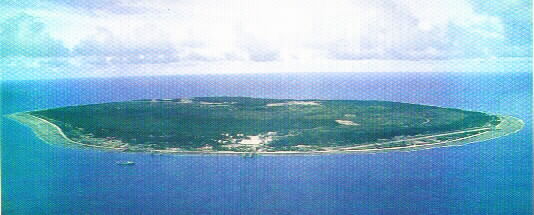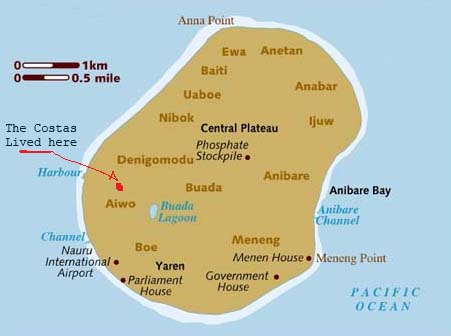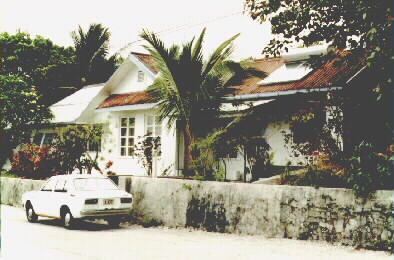

Nauru was a fantastic place for us to live. In the five years we lived on Nauru we were able to finally encounter peace and stability to our lives after we left Angola. Professionally, the jobs I undertook were not very demanding once I learnt sufficient English to make communication easier. With my "training" in Angola in dealing with people under duress the politics of Nauru were very tamed and caused no sweat to handle. I could concentrate on diving and photography.
We lived a quiet and enjoyable life in Nauru; there we started our lives in English speaking environments and for the large majority of people on the island English was a second language. It made learning so much easy because we did not have to feel embarrassed for not speaking it very well.
Being a small island and with so few people it provided a safe place to bring up our daughters. They started school there and Nauru primary education system provided them good foundations for the education they continue in Australia.
Diving was fabulous and we did it more than 500 times. I started underwater photography in Nauru and the beauty of the coral reef finally convinced Filomena to take the plunge despite the stories about sharks, deep diving and difficult entry and exit the reef.
The family enjoyed the quiet lifestyle and Erica and Rita roamed free on the Island and on the "free bus" the company provided.
We will try to provide a picture of the life on Nauru by telling some stories about the times we lived there.

Nauru in one shot
Nauru (in Naruan language Naoero), is an island and republic in the central Pacific Ocean, situated just south of the equator. It is a coral island, oval in shape, raising 500 m from the sea bed and with an area of 21 km2. The total population of about 8,000 being 4000 Nauruans and the rest expatriate workers for the phosphate mine and government agencies.
The Nauruans are of mixed Polynesian, Micronesian, and Melanesian origin. Most likely the Nauruans were descendants from the same people that populated the other Pacific Areas but the isolated location of the island may have contributed for a totally different language and even physical complexion of the Nauruans when compared with the other Islanders.
English is the language used by all the different nationalities and the official language for business.
Most of the people of Nauru live along a narrow, fertile coastal strip that encircles the island. The island resembles a hat with the central plateau, about 61 m in elevation, that contains rich deposits of high-quality phosphate rock. When we arrived on the island in 1981, approximately 2 million tonnes of phosphate a year was exported to Australia, New Zealand and a small quantity to Japan. The Island was approximately 75% mined out and a combination of lower demand with reduced efficiency of the mining operation saw the quantity of phosphate exported reduced every year.
Nauru was occupied by Germany since the beginning of the century but a young Australian prospector Albert Ellis discovered by accident the Nauru phosphate in 1897. Since then mining started but not at very fast pace. After the first world war (1920) England, Australia and New Zealand formed the British Phosphate Commissioners that took over the exploration and practically all activities on the Island. They mined several small Islands in the Pacific such as Ocean Island, Nauru and Makatea and Christmas Island in the Indian Ocean. During the Second World War the Japanese took over the island and convert it to a land-based aircraft carrier and transferred almost all Nauruans to Truk Islands in the Pacific. The surrender of the Japanese at the end of the war, was accepted by the Australians.
The Nauruans, returned to the Island from Truk after the war and eventually became an independent country on January 31, 1968. The old British Phosphate Commissioners turned into Nauru Phosphate Corporation totally owned by the Nauruan Government.
The Nauruans receive generous royalties for the mined phosphate. Part of this royalties are paid to the land owner and the rest invested by a Government owned fund that supposedly will invest the money to guarantee the future of the Nauruan population.
Note of 2015 - Unfortunately this did not happened and Nauru people is now paying dearly for their ingenuity.
With only 4000 people and a large majority being children and elders, the royalty money paid to the population has some interesting but in our opinion sad results.
Nauru was then one of the richest, per capita, countries in the world. However, the phosphate mining has severely damaged the island's environment, and by the time the phosphate mines are exhausted around the year 2000, about 80 percent of the island will be uninhabitable and will require extensive and very expensive rehabilitation.
Unfortunately the Nauruans have wasted most of their royalty money in failed ventures rather than in solid investments that would guarantee and income after the phosphate era. Time may prove me wrong (unfortunately it didn't) but I see Australia having to rescue Nauru after the “golden eggs” are all eaten.
We spent 6 years on Nauru and loved every moment of it. Nauru and its people provided us with the peace and tranquillity we needed to start rebuild our lives. We learnt English there and our daughters started their education in Nauruan schools. We had the opportunity to understand not only the Nauruan culture but also the Australians and their customs, which proved invaluable in our next move to Tasmania.


MQ 52 Our house in Nauru